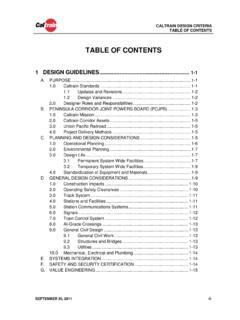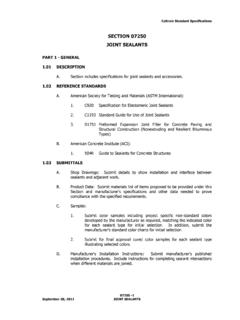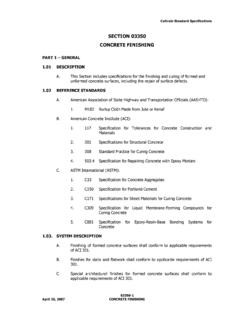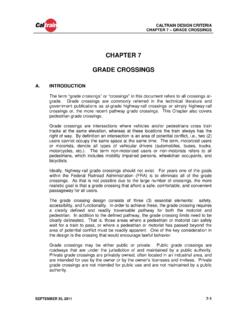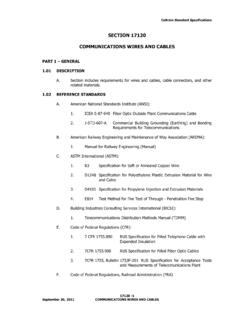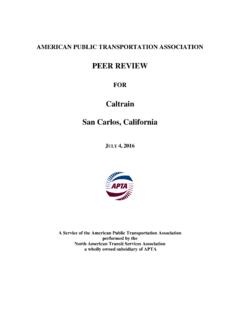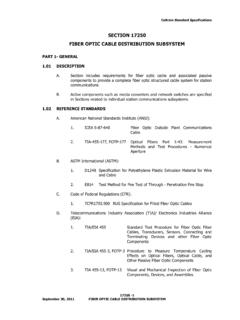Transcription of CHAPTER 6 TRAIN CONTROL COMMUNICATION
1 caltrain DESIGN CRITERIA. CHAPTER 6 TRAIN CONTROL COMMUNICATION . CHAPTER 6. TRAIN CONTROL COMMUNICATION . A. GENERAL. The Design Criteria presented in this CHAPTER for mission or operations critical TRAIN CONTROL COMMUNICATION defines the technical requirements used for the development of specifications and the design of the Advanced TRAIN CONTROL System (ATCS) Data Radio COMMUNICATION system, the various telephone interfaces and the Very High Frequency (VHF) Voice Radio COMMUNICATION system. The ATCS Data Radio and the VHF Voice Radio are both independent stand-alone COMMUNICATION systems which are each supported by a caltrain -owned microwave radio network and by various leased telephone subsystems, including T1, 4-Wire (Analog), 4-Wire E&M (Analog), 4-Wire (Digital), 2-Wire (Analog), Frame Relay and DSL for back-haul. The Design Criteria defines the requirements for these COMMUNICATION systems and sub-systems to safely and efficiently fully support the caltrain operations, as well as the requirements to expand these systems in order to support future caltrain COMMUNICATION needs.
2 The ATCS data radio network shall interface to, and the Voice Radio system shall support, the following future system safety and passenger enhancements: Positive TRAIN CONTROL (PTC) and California High Speed Rail (CHSR). In addition to these three (3) communications systems/sub-systems, there are several other communications sub-systems that are utilized by caltrain as follows: a. Public Address System (PAS). b. Closed Circuit Television (CCTV). c. Visual Message Sign (VMS). d. Fare Collection System (Ticket Vending Machine or TVM and fastrak payment system or the Clipper card). The Design Criteria for these sub-systems are addressed separately in CHAPTER 4. STATION COMMUNICATIONS. The designer(s) of the TRAIN CONTROL system shall be qualified Radio Communications Engineer(s), licensed in the State of California as professional Electrical Engineer(s). They shall have designed and integrated at least two similar projects in the last five years.
3 SEPTEMBER 30, 2011 6-1. caltrain DESIGN CRITERIA. CHAPTER 6 TRAIN CONTROL COMMUNICATION . B. ATCS DATA RADIO SYSTEM. All TRAIN movements on caltrain tracks are managed and controlled by a Non-Vital Supervisory CONTROL System. This supervisory CONTROL system is implemented via a data radio network, which connects the TRAIN signaling CONTROL Points (CPs) to the computer workstations, servers and packet switches located at the Central CONTROL Facility (CCF). The CCF is located at the caltrain CEMOF (Centralized Equipment, Maintenance, and Operations Facility) at 585 Lenzen Avenue, in San Jose. A. detailed description of each component of the data radio network and the CCF head- end interface is provided below. The data radio network is implemented via the use of ATCS channels 2 and 5. Each ATCS channel consists of a pair of Multiple- Addressing-Scheme frequencies in the 900 MHz band (set aside by the Federal Communications Commission, or FCC for this application) which implements the Advanced TRAIN CONTROL System (ATCS) Protocol.
4 The ATCS protocol is central to the 900 MHz band RF (Radio Frequency). COMMUNICATION links between the network of CONTROL Points and Base Stations, as well as to the base-band (DS0) data links between these Base Stations and the Packet Switches located at the CCF. CODE SERVER. At the CCF, the TRAIN dispatcher implements a route request by first inputting a CONTROL command into the Code Server. The Code Server decodes the command, and passes another encoded message to the Packet Switches, which have the dual function of ensuring that the output protocol to the Base Station network is implementing the ATCS protocol (gateway function) as well as deciding which Base Station site will be the most-likely-server for the CONTROL Point being commanded (router function). Until late 2011, caltrain used a Code Server developed by Digital Concepts, Incorporated (DigiCon). The DigiCon's Code Server does not implement the ATCS.
5 Protocol. Instead, a variety of other protocols are supported and the following protocols are implemented in the caltrain system: a. The Supervisory CONTROL Systems (SCS)-128 protocol, developed by Safetran Systems (now part of Invensys). This protocol is used for all direct telephone line links between CONTROL Points and the CCF, as well as for the links between the Base Station sites and the CCF. b. The Genisys Protocol, developed by Union Switch and Signal (now part of Ansaldo). This protocol is used only for the direct telephone link between the major CONTROL Point at Fourth Street and the CCF, and the leased line to CP. Army. As caltrain expands its data radio network, the use of the Genisys protocol, for the Fourth Street site will be replaced with ATCS. The Genisys application at CP Army will be converted to ATCS. Further, in order to improve data radio throughput, the use of an ATCS protocol directly on the DigiCon's Code Server shall be investigated.
6 The DigiCon's Code Server is a rack-mounted computer, using a proprietary operating system developed by DigiCon has the capability to support interfaces to multiple dispatch stations. SEPTEMBER 30, 2011 6-2. caltrain DESIGN CRITERIA. CHAPTER 6 TRAIN CONTROL COMMUNICATION . c. The DigiCon Console and code servers are currently being replaced with a new IP based dispatch console/head-end provided by AIRINC, called the AIM. dispatch head-end console. This new dispatch system which replaces the existing Digicon Console and servers begins service towards the end of 2011. PACKET SWITCHES. The CCF Packet Switches currently used in support of the ATCS data radio network are manufactured by Safetran Systems. They incorporate built-in hardware redundancy via the use of a dual packet-switch design in one box, one of which is redundant, and connected to the Code Server/FEP. The packet switches are capable of performing a dual role, where required.
7 They can perform protocol conversions, as needed as well as RSSI (Received Signal Strength Indicator) selection. Since the AIRINC's AIM /FEP utilize an ATCS over IP. protocol, this protocol conversion feature of the packet switch is not required for the interface to the AIM/FEP. However the Packet switches shall be set up to operate in dual mode. SCS-128 serial shall be connected to the DigiCon Code Servers. Additionally, ATCS over IP shall be the configuration used by the AIM system currently being implemented. Currently, the DigiCon system operates as primary with the AIM system under test. After the successful implementation of the full AIM. configuration, AIM shall become primary with DigiCon remaining as backup. The CCF Packet switches shall monitor the inbound signal quality RSSI from each of the three Base Station sites, corresponding to every transmission from a CONTROL Point, in order to determine which Base Station site received the strongest signal from the CONTROL Point.
8 This RSSI information shall be used by the Packet Switches to determine, in real time, which Base Station site will be the most-likely-server, and shall route the next message from the Code Server to this Base Station site. Note, this RSSI result is not saved for general future routing of messages to Base Station sites, but shall only be used, in real time, for routing only the next message to the most-likely-server Base Station site. NETWORK. The third major component of the Non-Vital Supervisory CONTROL System is the network of ATCS Data Radio Base Stations and CONTROL Points. The caltrain railroad consists of approximately 78 miles of railroad tracks serving freight and passenger operations between San Francisco and Gilroy. Currently, 31 CONTROL Points are in operation, between CP Fourth Street in the north and CP Michael in the south, of which 27 are on the ATCS data radio network. A total of three (3) Base Station sites are used to support all message transmissions between the CCF and these CONTROL Points.
9 The three Base Station sites used are located at San Bruno Mountain (SB) in Daly City, Monument Peak (MP) in Milpitas, and at the CEMOF in San Jose. The three Base Station sites are configured as redundant pairs on separate radio frequencies to the extent of their respective radio coverage footprints. The Monument Peak and San Bruno Mountain sites are each capable of providing ATCS. SEPTEMBER 30, 2011 6-3. caltrain DESIGN CRITERIA. CHAPTER 6 TRAIN CONTROL COMMUNICATION . data radio support to all of the northern CONTROL Points along the caltrain Corridor. The CEMOF and Monument Peak sites provide full radio coverage and/or coverage redundancy for the southern CONTROL points, with CP Michael at its south limit to CP. Mary as its north limit. Note, in order for a CONTROL Point to be added to the ATCS Data Radio network, the design criteria is that it must receive full radio coverage, with an availability of at least 99 percent, from a minimum of two Base Station sites, otherwise it shall be supported using leased telephone circuits.
10 CP Lick, which is the southernmost CP. along the railroad is not controlled by caltrain (it is controlled' by UP), but simply monitored , hence this coverage criterion does not apply to it. The ATCS network was designed to grow organically, however in order to preserve system throughput and efficiency, the following parameters must be analyzed prior to adding new CONTROL Points or Base Stations: a. The maximum number of CONTROL Points that can be safely served by one Base Station, given the required speeds and head-ways required for the efficient operation of the caltrain . For current caltrain maximum authorized speeds (MAS) of 79 mph and minimum head-ways of five (5) minutes, empirical data suggests that no more than about 15 CONTROL Points shall be supported by a single Base Station. In order to increase maximum speeds or reduce head-ways further, it will be necessary to obtain additional efficiency improvements by reducing the coding or protocol conversion overhead, or increasing the data rate of the base-band (DS0) channel between the Base Station sites and the Packet Switches.

